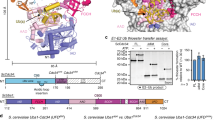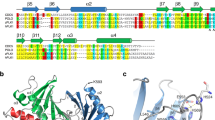Abstract
CDC25 dual-specificity phosphatases are essential regulators that activate cyclin-dependent kinases (CDKs) at critical stages of the cell cycle. In human cells, CDC25A and C are involved in the control of G1/S and G2/M respectively, whereas CDC25B is proposed to act both in S phase and G2/M. Evidence for an interaction between CDC25 phosphatases and members of the 14-3-3 protein family has been obtained in vitro and in vivo in several organisms. On the basis of the work performed with CDC25C, it has been proposed that phosphorylation is required to mediate the interaction with 14-3-3. Here we have examined the molecular basis of the interaction between CDC25B phosphatases and 14-3-3 proteins. We show that in the two-hybrid assay all three splice variants of CDC25B interact similarly and strongly with 14-3-3η, β and ζ proteins, but poorly with ε and Θ. In vitro, CDC25B interacts at a low level with 14-3-3β, ε, ζ, η, and Θ isoforms. This interaction is not increased upon phosphorylation of CDC25B by CHK1 and is not abolished by dephosphorylation. In contrast, a specific, strong interaction between CDC25B and 14-3-3ζ and η isoforms is revealed by a deletion of 288 residues in the amino-terminal region of CDC25B. This interaction requires the integrity of Ser 323, although it is independent of phosphorylation. Thus, interaction between 14-3-3 proteins and CDC25B is regulated in a manner that is different from that with CDC25C. We propose that, in addition to a low affinity binding site that is available for all 14-3-3 isoforms, post-translational modification of CDC25B in vivo exposes a high-affinity binding site that is specific for the ζ and η14-3-3 isoforms.
This is a preview of subscription content, access via your institution
Access options
Subscribe to this journal
Receive 50 print issues and online access
$259.00 per year
only $5.18 per issue
Buy this article
- Purchase on Springer Link
- Instant access to full article PDF
Prices may be subject to local taxes which are calculated during checkout







Similar content being viewed by others
Abbreviations
- MBP:
-
Maltose binding protein
- CHK1:
-
checkpoint kinase 1
References
Aitken A . 1995 Trends Biochem Sci 20: 95–97
Baldin V . 1999 Progress in Cell Cycle Research, Vol 4 L Meijer, A Jézéquel and B Ducommun eds New York, USA Plenum Press In press
Baldin V, Cans C, Superti-Furga G and Ducommun B . 1997 Oncogene 14: 2485–2495
Blomberg I and Hoffman I . 1999 Mol Cell Biol 19: 6183–6194
Chen L, Liu TH and Walworth NC . 1999 Genes Dev 13: 675–685
Clarke PR, Hoffmann I, Draetta G and Karsenti E . 1993 Mol Biol Cell 4: 397–411
Conklin DS, Galaktionov K and Beach D . 1995 Proc Natl Acad Sci USA 92: 7892–7896
Dalal SN, Schweitzer CM and DeCaprio JA . 1999 Mol Cell Biol 19: 4465–4479
Descombes P and Nigg EA . 1998 EMBO J 17: 1328–1335
Furnari B, Rhind N and Russell P . 1997 Science 277: 1495–1497
Gabrielli BG, De Souza CPC, Tonks ID, Clarck JM, Hatward NK and Ellem KAO . 1996 J Cell Sci 109: 1081–1093
Galaktionov K and Beach D . 1991 Cell 67: 1181–1194
Garner-Hamrick PA and Fischer C . 1998 Int J Cancer 76: 720–728
Gautier J, Solomon MJ, Booher RN, Bazan JF and Kirschner MW . 1991 Cell 67: 197–211
Hoffman I, Draetta I and Karsenti G . 1994 EMBO J 13: 4302–4310
Hoffmann I, Clarke P, Marcote MJ, Karsenti E and Draetta G . 1993 EMBO J 12: 53–63
Jessus C and Beach D . 1992 Cell 68: 323–332
Jinno S, Suto K, Nagata A, Igashari M, Kanaoka Y, Nojima H and Okayama H . 1994 EMBO J 13: 1549–1556
Jones DH, Ley S and Aitken A . 1995 FEBS Lett 368: 55–58
Kumagai A and Dunphy WG . 1999 Genes Dev 13: 1067–1072
Kumagai A and Dunphy WG . 1996 Science 273: 1377–1380
Kumagai A, Guo Z, Emami KH, Wang SX and Dunphy WG . 1998a J Cell Biol 142: 1559–1569
Kumagai A, Yakowec PS and Dunphy WG . 1998b Mol Biol Cell 9: 345–354
Lammer C, Wagerer S, Saffrich R, Mertens D, Ansorge W and Hoffman I . 1998 J Cell Sci 111: 2445–2453
Lopez-Girona A, Furnari B, Mondesert O and Russell P . 1999 Nature 397: 172–175
Matsuoka S, Huang M and Elledge SJ . 1998 Science 282: 1893–1897
Mueller PR, Coleman TR, Kumagai A and Dunphy WG . 1995 Science 270: 86–90
Nagata A, Igarashi M, Jinno S, Suto K and Okayama H . 1991 New Biol 3: 959–968
Nigg E . 1995 BioEssays 17: 471–480
Peng CY, Graves PR, Ogg S, Thoma RS, Byrnes MJ III, Wu Z, Stephenson MT and Piwnica-Worms H . 1998 Cell Growth Differ 9: 197–208
Peng CY, Graves PR, Thoma RS, Wu Z, Shaw AS and Piwnica-Worms H . 1997 Science 277: 1501–1505
Petosa C, Masters SC, Bankston LA, Pohl J, Wang B, Fu H and Liddington RC . 1998 J Biol Chem 273: 16305–16310
Russell P and Nurse P . 1986 Cell 45: 145–153
Russell P and Nurse P . 1987 Cell 49: 559–567
Sadhu K, Reed SI, Richardson H and Russell P . 1990 Proc Natl Acad Sci USA 87: 5139–5143
Sanchez Y, Wong C, Thoma RS, Richman R, Wu Z, Piwnica-Worms H and Elledge S . 1997 Science 277: 1497–1501
Smith D and Johnson K . 1988 Gene 67: 31–40
Superti-Furga G, Berges G, Picard D and Busslinger M . 1991 Proc Natl Acad Sci USA 88: 5144–5118
Walworth NC and Bernards R . 1996 Science 271: 353–356
Weiss A and Schlessinger J . 1998 Cell 94: 277–280
Xu X and Burke SP . 1996 J Biol Chem 271: 5118–5124
Yang J, Winkler K, Yoshida M and Kornbluth S . 1999 EMBO J 18: 2174–2183
Zheng XF and Ruderman JV . 1993 Cell 75: 155–164
Acknowledgements
We gratefully acknowledge M Yaffe, H Robertson and H Yasuda for the gift plasmids, M Knibiehler for technical assistance, D Mathieu for reagents, and to J Smith and J Hyams for critical reading of the manuscript. This work was supported by the CNRS, l'Université Paul Sabatier, l'Association pour la Recherche sur le Cancer, l'Association Pour la Recherche sur l'Ataxie Télangiectasie, la Ligue Nationale Contre le Cancer and la Ligue Contre le Cancer comité de la Haute-Garonne and comité des Yvelines.
Author information
Authors and Affiliations
Rights and permissions
About this article
Cite this article
Mils, V., Baldin, V., Goubin, F. et al. Specific interaction between 14-3-3 isoforms and the human CDC25B phosphatase. Oncogene 19, 1257–1265 (2000). https://doi.org/10.1038/sj.onc.1203419
Received:
Revised:
Accepted:
Published:
Issue Date:
DOI: https://doi.org/10.1038/sj.onc.1203419
Keywords
This article is cited by
-
Down-regulation of 14-3-3zeta reduces proliferation and increases apoptosis in human glioblastoma
Cancer Gene Therapy (2020)
-
14-3-3γ Prevents Centrosome Amplification and Neoplastic Progression
Scientific Reports (2016)
-
High expression of Cdc25B and low expression of 14-3-3σ is associated with the development and poor prognosis in urothelial carcinoma of bladder
Tumor Biology (2014)
-
Targeting 14-3-3zeta in cancer therapy
Cancer Gene Therapy (2012)
-
14-3-3 zeta
AfCS-Nature Molecule Pages (2011)



